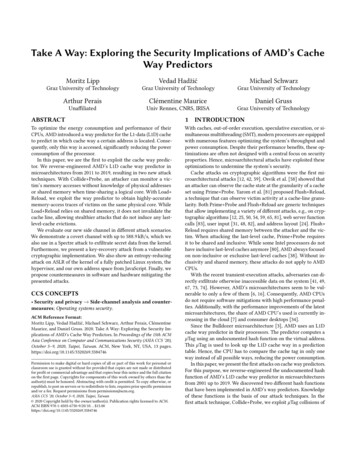
Transcription
Take A Way: Exploring the Security Implications of AMD’s CacheWay PredictorsMoritz LippGraz University of TechnologyArthur PeraisUnaffiliatedVedad HadžićGraz University of TechnologyClémentine MauriceUniv Rennes, CNRS, IRISAMichael SchwarzGraz University of TechnologyDaniel GrussGraz University of TechnologyABSTRACT1To optimize the energy consumption and performance of theirCPUs, AMD introduced a way predictor for the L1-data (L1D) cacheto predict in which cache way a certain address is located. Consequently, only this way is accessed, significantly reducing the powerconsumption of the processor.In this paper, we are the first to exploit the cache way predictor. We reverse-engineered AMD’s L1D cache way predictor inmicroarchitectures from 2011 to 2019, resulting in two new attacktechniques. With Collide Probe, an attacker can monitor a victim’s memory accesses without knowledge of physical addressesor shared memory when time-sharing a logical core. With Load Reload, we exploit the way predictor to obtain highly-accuratememory-access traces of victims on the same physical core. WhileLoad Reload relies on shared memory, it does not invalidate thecache line, allowing stealthier attacks that do not induce any lastlevel-cache evictions.We evaluate our new side channel in different attack scenarios.We demonstrate a covert channel with up to 588.9 kB/s, which wealso use in a Spectre attack to exfiltrate secret data from the kernel.Furthermore, we present a key-recovery attack from a vulnerablecryptographic implementation. We also show an entropy-reducingattack on ASLR of the kernel of a fully patched Linux system, thehypervisor, and our own address space from JavaScript. Finally, wepropose countermeasures in software and hardware mitigating thepresented attacks.With caches, out-of-order execution, speculative execution, or simultaneous multithreading (SMT), modern processors are equippedwith numerous features optimizing the system’s throughput andpower consumption. Despite their performance benefits, these optimizations are often not designed with a central focus on securityproperties. Hence, microarchitectural attacks have exploited theseoptimizations to undermine the system’s security.Cache attacks on cryptographic algorithms were the first microarchitectural attacks [12, 42, 59]. Osvik et al. [58] showed thatan attacker can observe the cache state at the granularity of a cacheset using Prime Probe. Yarom et al. [81] proposed Flush Reload,a technique that can observe victim activity at a cache-line granularity. Both Prime Probe and Flush Reload are generic techniquesthat allow implementing a variety of different attacks, e.g., on cryptographic algorithms [12, 25, 50, 54, 59, 65, 81], web server functioncalls [83], user input [31, 48, 82], and address layout [24]. Flush Reload requires shared memory between the attacker and the victim. When attacking the last-level cache, Prime Probe requiresit to be shared and inclusive. While some Intel processors do nothave inclusive last-level caches anymore [80], AMD always focusedon non-inclusive or exclusive last-level caches [38]. Without inclusivity and shared memory, these attacks do not apply to AMDCPUs.With the recent transient-execution attacks, adversaries can directly exfiltrate otherwise inaccessible data on the system [41, 49,67, 73, 74]. However, AMD’s microarchitectures seem to be vulnerable to only a few of them [6, 16]. Consequently, AMD CPUsdo not require software mitigations with high performance penalties. Additionally, with the performance improvements of the latestmicroarchitectures, the share of AMD CPU’s used is currently increasing in the cloud [7] and consumer desktops [34].Since the Bulldozer microarchitecture [3], AMD uses an L1Dcache way predictor in their processors. The predictor computes a𝜇Tag using an undocumented hash function on the virtual address.This 𝜇Tag is used to look up the L1D cache way in a predictiontable. Hence, the CPU has to compare the cache tag in only oneway instead of all possible ways, reducing the power consumption.In this paper, we present the first attacks on cache way predictors.For this purpose, we reverse-engineered the undocumented hashfunction of AMD’s L1D cache way predictor in microarchitecturesfrom 2001 up to 2019. We discovered two different hash functionsthat have been implemented in AMD’s way predictors. Knowledgeof these functions is the basis of our attack techniques. In thefirst attack technique, Collide Probe, we exploit 𝜇Tag collisions ofCCS CONCEPTS Security and privacy Side-channel analysis and countermeasures; Operating systems security.ACM Reference Format:Moritz Lipp, Vedad Hadžić, Michael Schwarz, Arthur Perais, ClémentineMaurice, and Daniel Gruss. 2020. Take A Way: Exploring the Security Implications of AMD’s Cache Way Predictors. In Proceedings of the 15th ACMAsia Conference on Computer and Communications Security (ASIA CCS ’20),October 5–9, 2020, Taipei, Taiwan. ACM, New York, NY, USA, 13 ssion to make digital or hard copies of all or part of this work for personal orclassroom use is granted without fee provided that copies are not made or distributedfor profit or commercial advantage and that copies bear this notice and the full citationon the first page. Copyrights for components of this work owned by others than theauthor(s) must be honored. Abstracting with credit is permitted. To copy otherwise, orrepublish, to post on servers or to redistribute to lists, requires prior specific permissionand/or a fee. Request permissions from permissions@acm.org.ASIA CCS ’20, October 5–9, 2020, Taipei, Taiwan 2020 Copyright held by the owner/author(s). Publication rights licensed to ACM.ACM ISBN 978-1-4503-6750-9/20/10. . . UCTION
ASIA CCS ’20, October 5–9, 2020, Taipei, Taiwanvirtual addresses to monitor the memory accesses of a victim timesharing the same logical core. Collide Probe does not require sharedmemory between the victim and the attacker, unlike Flush Reload,and no knowledge of physical addresses, unlike Prime Probe. In thesecond attack technique, Load Reload, we exploit the property thata physical memory location can only reside once in the L1D cache.Thus, accessing the same location with a different virtual addressevicts the location from the L1D cache. This allows an attacker tomonitor memory accesses on a victim, even if the victim runs on asibling logical core. Load Reload is on par with Flush Reload interms of accuracy and can achieve a higher temporal resolutionas it does not invalidate a cache line in the entire cache hierarchy.This allows stealthier attacks that do not induce last-level-cacheevictions.We demonstrate the implications of Collide Probe and Load Reload in different attack scenarios. First, we implement a covertchannel between two processes with a transmission rate of up to588.9 kB/s outperforming state-of-the-art covert channels. Second,we use 𝜇Tag collisions to reduce the entropy of different ASLRimplementations. We break kernel ASLR on a fully updated Linuxsystem and demonstrate entropy reduction on user-space applications, the hypervisor, and even on our own address space fromsandboxed JavaScript. Furthermore, we successfully recover thesecret key using Collide Probe on an AES T-table implementation.Finally, we use Collide Probe as a covert channel in a Spectre attackto exfiltrate secret data from the kernel. While we still use a cachebased covert channel, in contrast to previous attacks [41, 44, 51, 69],we do not rely on shared memory between the user application andthe kernel. We propose different countermeasures in software andhardware, mitigating Collide Probe and Load Reload on currentsystems and in future designs.Contributions. The main contributions are as follows:(1) We reverse engineer the L1D cache way predictor of AMDCPUs and provide the addressing functions for virtually allmicroarchitectures.(2) We uncover the L1D cache way predictor as a source ofside-channel leakage and present two new cache-attack techniques, Collide Probe and Load Reload.(3) We show that Collide Probe is on par with Flush Reloadand Prime Probe but works in scenarios where other cacheattacks fail.(4) We demonstrate and evaluate our attacks in sandboxedJavaScript and virtualized cloud environments.Responsible Disclosure. We responsibly disclosed our findings toAMD on August 23rd, 2019.Outline. Section 2 provides background information on CPUcaches, cache attacks, way prediction, and simultaneous multithreading (SMT). Section 3 describes the reverse engineering of theway predictor that is necessary for our Collide Probe and Load Reload attack techniques outlined in Section 4. In Section 5, weevaluate the attack techniques in different scenarios. Section 6 discusses the interactions between the way predictor and other CPUfeatures. We propose countermeasures in Section 7 and concludeour work in Section 8.Lipp, et al.2BACKGROUNDIn this section, we provide background on CPU caches, cache attacks, high-resolution timing sources, simultaneous multithreading(SMT), and way prediction.2.1CPU CachesCPU caches are a type of memory that is small and fast, that theCPU uses to store copies of data from main memory to hide thelatency of memory accesses. Modern CPUs have multiple cachelevels, typically three, varying in size and latency: the L1 cache isthe smallest and fastest, while the L3 cache, also called the last-levelcache, is bigger and slower.Modern caches are set-associative, i.e., a cache line is stored in afixed set determined by either its virtual or physical address. The L1cache typically has 8 ways per set, and the last-level cache has 12 to20 ways, depending on the size of the cache. Each line can be storedin any of the ways of a cache set, as determined by the replacementpolicy. While the replacement policy for the L1 and L2 data cacheon Intel is most of the time pseudo least-recently-used (LRU) [1],the replacement policy for the last-level cache (LLC) can differ [78].Intel CPUs until Sandy Bridge use pseudo least-recently-used (LRU),for newer microarchitectures it is undocumented [78].The last-level cache is physically indexed and shared acrosscores of the same CPU. In most Intel implementations, it is alsoinclusive of L1 and L2, which means that all data in L1 and L2 isalso stored in the last-level cache. On AMD Zen processors, the L1Dcache is virtually indexed and physically tagged (VIPT). On AMDprocessors, the last-level cache is a non-inclusive victim cache whileon most Intel CPUs it is inclusive. To maintain the inclusivenessproperty, every line evicted from the last-level cache is also evictedfrom L1 and L2. The last-level cache, though shared across cores,is also divided into slices. The undocumented hash function onIntel CPUs that maps physical addresses to slices has been reverseengineered [52].2.2Cache AttacksCache attacks are based on the timing difference between accessingcached and non-cached memory. They can be leveraged to buildside-channel attacks and covert channels. Among cache attacks,access-driven attacks are the most powerful ones, where an attackermonitors its own activity to infer the activity of its victim. Morespecifically, an attacker detects which cache lines or cache sets thevictim has accessed.Access-driven attacks can further be categorized into two types,depending on whether or not the attacker shares memory withits victim, e.g., using a shared library or memory deduplication.Flush Reload [81], Evict Reload [31] and Flush Flush [30] all relyon shared memory that is also shared in the cache to infer whetherthe victim accessed a particular cache line. The attacker evicts theshared data either by using the clflush instruction (Flush Reloadand Flush Flush), or by accessing congruent addresses, i.e., cachelines that belong to the same cache set (Evict Reload). These attacks have a very fine granularity (i.e., a 64-byte memory region),but they are not applicable if shared memory is not available in thecorresponding environment. Especially in the cloud, shared memory is usually not available across VMs as memory deduplication is
Take A Way: Exploring the Security Implications of AMD’s Cache Way Predictorsdisabled for security concerns [75]. Irazoqui et al. [38] showed thatan attack similar to Flush Reload is also possible in a cross-CPUattack. It exploits that cache invalidations (e.g., from clflush) arepropagated to all physical processors installed in the same system.When reloading the data, as in Flush Reload, they can distinguishthe timing difference between a cache hit in a remote processorand a cache miss, which goes to DRAM.The second type of access-driven attacks, called Prime Probe [37,50, 59], does not rely on shared memory and is, thus, applicable tomore restrictive environments. As the attacker has no shared cacheline with the victim, the clflush instruction cannot be used. Thus,the attacker has to access congruent addresses instead (cf. Evict Reload). The granularity of the attack is coarser, i.e., an attacker onlyobtains information about the accessed cache set. Hence, this attackis more susceptible to noise. In addition to the noise caused by otherprocesses, the replacement policy makes it hard to guarantee thatdata is actually evicted from a cache set [29].With the general development to switch from inclusive caches tonon-inclusive caches, Intel introduced cache directories. Yan et al.[80] showed that the cache directory is still inclusive, and an attacker can evict a cache directory entry of the victim to invalidatethe corresponding cache line. This allows mounting Prime Probeand Evict Reload attacks on the cache directory. They also analyzed whether the same attack works on AMD Piledriver and Zenprocessors and discovered that it does not, because these processorseither do not use a directory or use a directory with high associativity, preventing cross-core eviction either way. Thus, it remainsto be answered what types of eviction-based attacks are feasible onAMD processors and on which microarchitectural structures.2.3High-resolution TimingFor most cache attacks, the attacker requires a method to measuretiming differences in the range of a few CPU cycles. The rdtscinstruction provides unprivileged access to a model-specific registerreturning the current cycle count and is commonly used for cacheattacks on Intel CPUs. Using this instruction, an attacker can gettimestamps with a resolution between 1 and 3 cycles on modernCPUs. On AMD CPUs, this register has a cycle-accurate resolutionuntil the Zen microarchitecture. Since then, it has a significantlylower resolution as it is only updated every 20 to 35 cycles (cf.Appendix A). Thus, rdtsc is only sufficient if the attacker canrepeat the measurement and use the average timing differencesover all executions. If an attacker tries to monitor one-time events,the rdtsc instruction on AMD cannot directly be used to observetiming differences, which are only a few CPU cycles.The AMD Ryzen microarchitecture provides the Actual Performance Frequency Clock Counter (APERF counter) [4] which can beused to improve the accuracy of the timestamp counter. However,it can only be accessed in kernel mode. Although other timingprimitives provided by the kernel, such as get monotonic time,provide nanosecond resolution, they can be more noisy and stillnot sufficiently accurate to observe timing differences, which areonly a few CPU cycles.Hence, on more recent AMD CPUs, it is necessary to resort to adifferent method for timing measurements. Lipp et al. [48] showedthat counting threads can be used on ARM-based devices whereASIA CCS ’20, October 5–9, 2020, Taipei, Taiwanunprivileged high-resolution timers are unavailable. Schwarz et al.[65] showed that a counting thread can have a higher resolutionthan the rdtsc instruction on Intel CPUs. A counting thread constantly increments a global variable used as a timestamp withoutrelying on microarchitectural specifics and, thus, can also be usedon AMD CPUs.2.4Simultaneous Multithreading (SMT)Simultaneous Multithreading (SMT) allows optimizing the efficiency of superscalar CPUs. SMT enables multiple independentthreads to run in parallel on the same physical core sharing thesame resources, e.g., execution units and buffers. This allows utilizing the available resources better, increasing the efficiency andthroughput of the processor. While on an architectural level, thethreads are isolated from each other and cannot access data of otherthreads, on a microarchitectural level, the same physical resourcesmay be used. Intel introduced SMT as Hyperthreading in 2002. AMDintroduced 2-way SMT with the Zen microarchitecture in 2017.Recently, microarchitectural attacks also targeted different sharedresources: the TLB [23], store buffer [15], execution ports [8, 13],fill-buffers [67, 74], and load ports [67, 74].2.5Way PredictionTo look up a cache line in a set-associative cache, bits in the addressdetermine in which set the cache line is located. With an 𝑛-waycache, 𝑛 possible entries need to be checked for a tag match. Toavoid wasting power for 𝑛 comparisons leading to a single match,Inoue et al. [36] presented way prediction for set-associative caches.Instead of checking all ways of the cache, a way is predicted, andonly this entry is checked for a tag match. As only one way isactivated, the power consumption is reduced. If the prediction iscorrect, the access has been completed, and access times similar toa direct-mapped cache are achieved. If the prediction is incorrect, anormal associative check has to be performed.We only describe AMD’s way predictor [5, 22] in more detailin the following section. However, other CPU manufacturers holdpatents for cache way prediction as well [56, 63]. CPU’s like theAlpha 21264 [40] also implement way prediction to combine theadvantages of set-associative caches and the fast access time of adirect-mapped cache.3REVERSE-ENGINEERING AMDS WAYPREDICTORIn this section, we explain how to reverse-engineer the L1D waypredictor used in AMD CPUs since the Bulldozer microarchitecture.First, we explain how the AMD L1D way predictor predicts theL1D cache way based on hashed virtual addresses. Second, wereverse-engineer the undocumented hash function used for the wayprediction in different microarchitectures. With the knowledge ofthe hash function and how the L1D way predictor works, we canthen build powerful side-channel attacks exploiting AMD’s waypredictor.3.1Way PredictorSince the AMD Bulldozer microarchitecture, AMD uses a way predictor in the L1 data cache [3]. By predicting the cache way, the CPU
ASIA CCS ’20, October 5–9, 2020, Taipei, TaiwanLipp, et al.Way 1Way 𝑛.𝜇 TagSet𝜇 TagHashVA 𝜇TagWay PredictionL1DEarly MissL2Figure 1: Simplified illustration of AMD’s way predictor.only has to compare the cache tag in one way instead of all ways.While this reduces the power consumption of an L1D lookup [5], itmay increase the latency in the case of a misprediction.Every cache line in the L1D cache is tagged with a linear-addressbased 𝜇Tag [5, 22]. This 𝜇Tag is computed using an undocumentedhash function, which takes the virtual address as the input. Forevery memory load, the way predictor predicts the cache way ofevery memory load based on this 𝜇Tag. As the virtual address, andthus the 𝜇Tag, is known before the physical address, the CPU doesnot have to wait for the TLB lookup. Figure 1 illustrates AMD’sway predictor. If there is no match for the calculated 𝜇Tag, an earlymiss is detected, and a request to L2 issued.Aliased cache lines can induce performance penalties, i.e., twodifferent virtual addresses map to the same physical location. VIPTcaches with a size lower or equal the number of ways multiplied bythe page size behave functionally like PIPT caches. Hence, there areno duplicates for aliased addresses and, thus, in such a case wheredata is loaded from an aliased address, the load sees an L1D cachemiss and thus loads the data from the L2 data cache [5]. If thereare multiple memory loads from aliased virtual addresses, they allsuffer an L1D cache miss. The reason is that every load updatesthe 𝜇Tag and thus ensures that any other aliased address sees anL1D cache miss [5]. In addition, if two different virtual addressesyield the same 𝜇Tag, accessing one after the other yields a conflictin the 𝜇Tag table. Thus, an L1D cache miss is suffered, and the datais loaded from the L2 data cache.3.2Hash FunctionThe L1D way predictor computes a hash (𝜇Tag) from the virtualaddress, which is used for the lookup to the way-predictor table.We assume that this undocumented hash function is linear basedon the knowledge of other such hash functions, e.g., the cache-slicefunction of Intel CPUs [52], the DRAM-mapping function of Intel,ARM, and AMD CPUs [2, 60, 70], or the hash function for indirectbranch prediction on Intel CPUs [41]. Moreover, we expect the sizeof the 𝜇Tag to be a power of 2, resulting in a linear function.We rely on 𝜇Tag collisions to reverse-engineer the hash function.We pick two random virtual addresses that map to the same cacheset. If the two addresses have the same 𝜇Tag, repeatedly accessingthem one after the other results in conflicts. As the data is thenloaded from the L2 cache, we can either measure an increased accesstime or observe an increased number in the performance counterfor L1 misses, as illustrated in Figure 2.Creating Sets. With the ability to detect conflicts, we can build𝑁 sets representing the number of entries in the 𝜇Tag table. First,we create a pool 𝑣 of virtual addresses, which all map to the samecache set, i.e., where bits 6 to 11 of the virtual address are the same.We start with one set 𝑆 0 containing one random virtual addressout of the pool 𝑣. For each other randomly-picked address 𝑣 𝑥 , wemeasure the access time while alternatively accessing 𝑣 𝑥 and anaddress from each set 𝑆 0.𝑛 . If we encounter a high access time, wemeasure conflicts and add 𝑣 𝑥 to that set. If 𝑣 𝑥 does not conflict withany existing set, we create a new set 𝑆𝑛 1 containing 𝑣 𝑥 .In our experiments, we recovered 256 sets. Due to measurementerrors caused by system noise, there are sets with single entriesthat can be discarded. Furthermore, to retrieve all sets, we need tomake sure to test against virtual addresses where a wide range ofbits is set covering the yet unknown bits used by the hash function.Recovering the Hash Function. Every virtual address, which is inthe same set, produces the same hash. To recover the hash function,we need to find which bits in the virtual address are used for the8 output bits that map to the 256 sets. Due to its linearity, eachoutput bit of the hash function can be expressed as a series of XORsof bits in the virtual address. Hence, we can express the virtualaddresses as an over-determined linear equation system in finitefield 2, i.e., GF(2). The solutions of the equation system are thenlinear functions that produce the 𝜇Tag from the virtual address.To build the equation system, we use each of the virtual addressesin the 256 sets. For every virtual address, the 𝑏 bits of the virtualaddress 𝑎 are the coefficients, and the bits of the hash function 𝑥 arethe unknown. The right-hand side of the equation 𝑦 is the same forall addresses in the set. Hence, for every address 𝑎 in set 𝑠, we getan equation of the form 𝑎𝑏 1𝑥𝑏 1 𝑎𝑏 2𝑥𝑏 2 · · · 𝑎 12𝑥 12 𝑦𝑠 .While the least-significant bits 0-5 define the cache line offset,note that bits 6-11 determine the cache set and are not used for the𝜇Tag computation [5]. To solve the equation system, we used theZ3 SMT solver. Every solution vector represents a function whichXORs the virtual-address bits that correspond to ‘1’-bits in thesolution vector. The hash function is the set of linearly independentfunctions, i.e., every linearly independent function yields one bitof the hash function. The order of the bits cannot be recovered.However, this is not relevant, as we are only interested whetheraddresses collide, not in their numeric 𝜇Tag value.We successfully recovered the undocumented 𝜇Tag hash functionon the AMD Zen, Zen and Zen 2 microarchitecture. The functionillustrated in Figure 3a uses bits 12 to 27 to produce an 8-bit valuemapping to one of the 256 sets:ℎ(𝑣) (𝑣 12 𝑣 27 ) (𝑣 13 𝑣 26 ) (𝑣 14 𝑣 25 ) (𝑣 15 𝑣 20 ) (𝑣 16 𝑣 21 ) (𝑣 17 𝑣 22 ) (𝑣 18 𝑣 23 ) (𝑣 19 𝑣 24 )We recovered the same function for various models of the AMDZen microarchitectures that are listed in Table 1. For the Bulldozermicroarchitecture (FX-4100), the Piledriver microarchitecture (FX8350), and the Steamroller microarchitecture (A10-7870K), the hashfunction uses the same bits but in a different combination Figure 3b.3.3Simultaneous MultithreadingAs AMD introduced simultaneous multithreading starting with theZen microarchitecture, the filed patent [22] does not cover any
MeasurementsTake A Way: Exploring the Security Implications of AMD’s Cache Way Predictors2,000ASIA CCS ’20, October 5–9, 2020, Taipei, TaiwanNon-colliding addresses1,500Colliding addresses1,0005000050100150200Access time (increments)Figure 2: Measured duration of 250 alternating accesses toaddresses with and without the same 141312.𝑓4𝑓5𝑓6𝑓7𝑓8(a) Zen, Zen , Zen 232221201918171615141312.(b) Bulldozer, Piledriver, SteamrollerFigure 3: The recovered hash functions use bits 12 to 27 ofthe virtual address to compute the 𝜇Tag.insights on how the way predictor might handle multiple threads.While the way predictor has been used since the Bulldozer microarchitecture [3], parts of the way predictor have only been documented with the release of the Zen microarchitecture [5]. However,the influence of simultaneous multithreading is not mentioned.Typically, two sibling threads can either share a hardware structure competitively with the option to tag entries or by staticallypartitioning them. For instance, on the Zen microarchitecture, execution units, schedulers, or the cache are competitively shared,and the store queue and retire queue are statically partitioned [17].Although the load queue, as well as the instruction and data TLB,are competitively shared between the threads, the data in thesestructures can only be accessed by the thread owning it.Under the assumption that the data structures of the way predictor are competitively shared between threads, one thread coulddirectly influence the sibling thread, enabling cross-thread attacks.We validate this assumption by accessing two addresses with thesame 𝜇Tag on both threads. However, we do not observe collisions,neither by measuring the access time nor in the number of L1 misses.While we reverse-engineered the same mapping function (see Section 3.2) for both threads, the possibility remains that additionalper-thread information is used for selecting the data-structure entry,allowing one thread to evict entries of the other.Hence, we extend the experiment in accessing addresses mappingto all possible 𝜇Tags on one hardware thread (and all possible cachesets). While we repeatedly accessed one of these addresses on onehardware thread, we measure the number of L1 misses to a singlevirtual address on the sibling thread. However, we are not able toobserve any collisions and, thus, conclude that either individualstructures are used per thread or that they are shared but tagged foreach thread. The only exceptions are aliased loads as the hardwareupdates the 𝜇Tag in the aliased way (see Section 3.1).In another experiment, we measure access times of two virtualaddresses that are mapped to the same physical address. As documented [5], loads to an aliased address see an L1D cache miss and,thus, load the data from the L2 data cache. While we verified thisbehavior, we additionally observed that this is also the case if theother thread performs the other load. Hence, the structure used issearched by the sibling thread, suggesting a competitively sharedstructure that is tagged with the hardware threads.4USING THE WAY PREDICTOR FOR SIDECHANNELSIn this section, we present two novel side channels that leverageAMD’s L1D cache way predictor. With Collide Probe, we monitor memory accesses of a victim’s process without requiring theknowledge of physical addresses. With Load Reload, while relyingon shared memory similar to Flush Reload, we can monitor memory accesses of a victim’s process running on the sibling hardwarethread without invalidating the targeted cache line from the entirecache hierarchy.4.1Collide ProbeCollide Probe is a new cache side channel exploiting 𝜇Tag collisionsin AMD’s L1D cache way predictor. As described in Section 3, theway predictor uses virtual-address-based 𝜇Tags to predict the L1Dcache way. If an address is accessed, the 𝜇Tag is computed, and theway-predictor entry for this 𝜇Tag is updated. If a subsequent accessto a different address with the same 𝜇Tag is performed, a 𝜇Tagcollision occurs, and the data has to be loaded from the L2D cache,increasing the access time. With Collide Probe, we exploit thistiming difference to monitor accesses to such colliding addresses.Threat Model. For this attack, we assume that the attacker has unprivileged native code execution on the target machine and runs onthe same logical CPU core as the victim. Furthermore, the attackercan force the execution of the victim’s code, e.g., via a function callin a library or a system call.Setup. The attacker first chooses a virtual address 𝑣 of the victimthat should be monitored for accesses. This can be an arbitraryvalid address in the victim’s address space. There are no constraintsin choosing the address. The attacker can then compute the 𝜇Tag𝜇 𝑣 of the target address using the hash function from Section 3.2.We assume that ASLR is either not active or has already beenbroken (cf. Section 5.2). However, although with ASLR, the actualvirtual
way instead of all possible ways, reducing the power consumption. In this paper, we present the first attacks on cache way predictors. . On AMD Zen processors, the L1D cache is virtually indexed and physically tagged (VIPT). The last-level cache is a non











